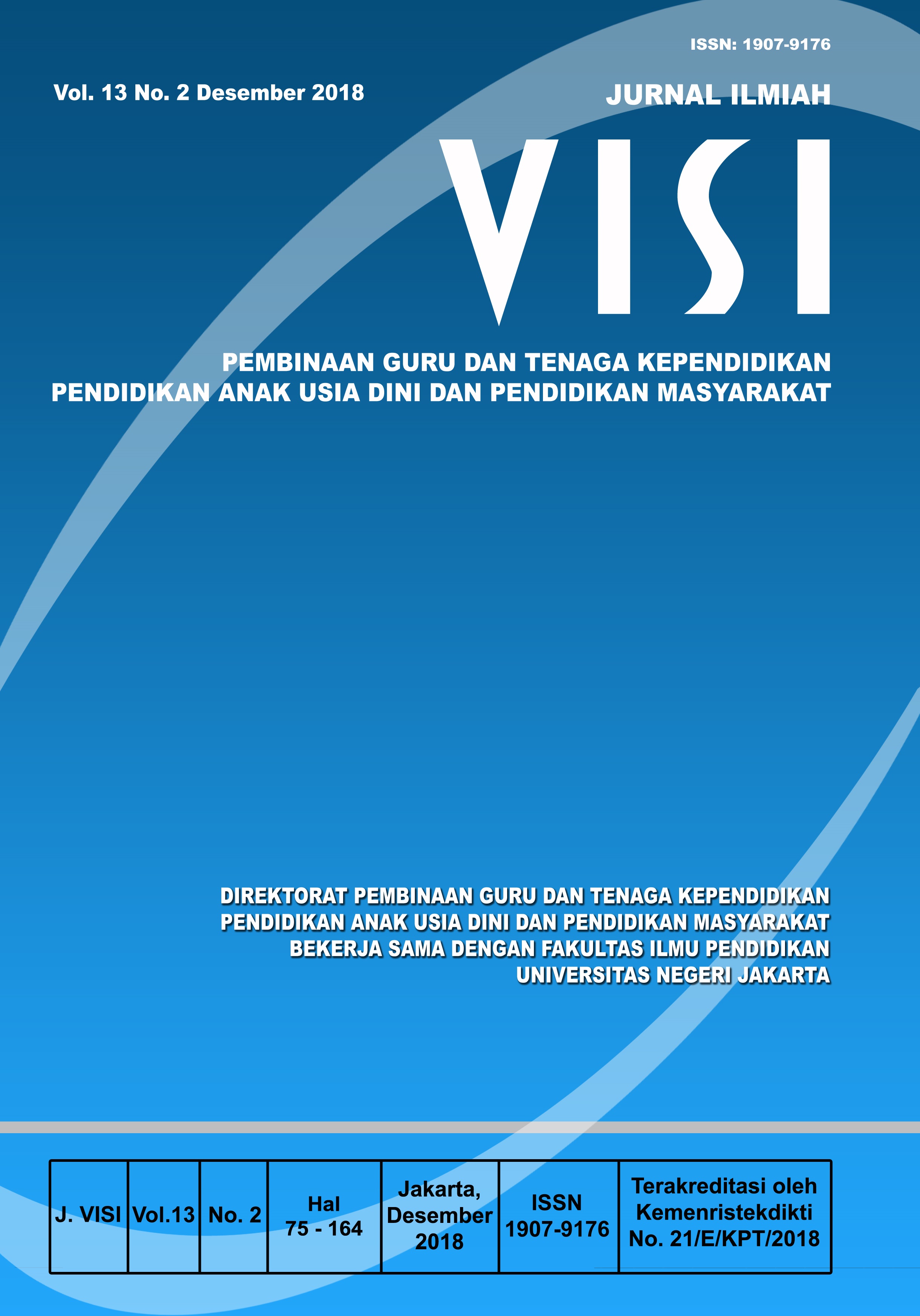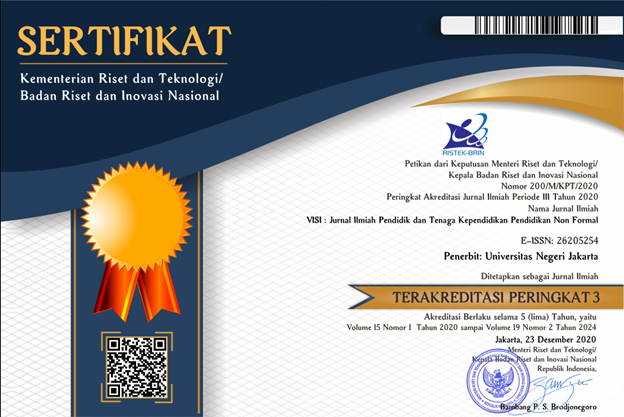AKSESIBILITAS ANAK MENGIKUTI PENDIDIKAN ANAK USIA DINI DI KABUPATEN SUMEDANG
DOI:
https://doi.org/10.21009/JIV.1302.4Keywords:
accessibilities, children, early childhood education programs, familyAbstract
The early age is a substantial period in human development. The long-term benefit from participating in the early childhood education programs is increasing opportunities for the children to complete their higher education in order to get the better welfare future. In Sumedang regency - the location of this study - the children’s participations in joining the early childhood education programs had not been optimized yet. Approximately 47% of the children aged 4-6 years had not participated in the early childhood education programs yet. Thus, it was significant to seek out the factors influencing the children’s accessibilities to participate in the early childhood education programs in Sumedang regency in order to find out the alternative policy to increase their accessibilities to participate in the early childhood
education programs. The research was conducted in 2017 using the quantitative method. The data were obtained from the “2015 Susenas†which involved 300 respondents. The data analysis was performed by using the logistic regression with the 12th version of STATA software. The findings showed that the children’s accessibilities to participate in the early childhood education programs in Sumedang regency was determined by the educational background of the head of family, the marital status of the parents, the head of the family’s income, the number of the family members, and the children’s domicile. Giving knowledge about the importance of early childhood education to the lower educational background parents and enlarging the early childhood schools’ facilities and infrastructures especially in rural areas of Sumedang regency still needed to be improved in order to have better human resources in the future.
References
Abdulhak, I. (2003). Memposisikan pendidikan anak usia dini dalam sistem pendidikan nasional. Buletin PADU Jurnal Ilmiah Anak Dini Usia. Jakarta: Dir. PAUD, Dirjend. PLSP, Depdiknas.
Apriana, R. (2009). Hubungan Pendidikan Anak Usia Dini (PAUD) dengan perkembangan kognitif anak usia prasekolah di Kelurahan Tinmojoyo Kecamatan Banyumanik Semarang. Skripsi. Semarang: Universitas Diponegoro.
Aristin, N. F. (2015). Faktor-faktor yang berpengaruh terhadap anak putus sekolah tingkat Sekolah Menengah Pertama (SMP) di Kecamatan Bondowoso. Jurnal Pendidikan Geografi, 20(1). 30-36. doi: http://dx.doi.org/10.17977/pg.v20i1.5009
Bappeda Kab. Sumedang. (2015). Profil daerah Kabupaten Sumedang. Diakses melalui http://www.sumedangkab.go.id/
Berlinski, S. G., Galiani, S., & Gertler, P. (2006). The effect of pre-primary education on primary school performance. Diakses melalui http://eprints.ucl.ac.uk/15418/
Black, M. M., Walker, S. P., Fernald, L. C. H., Andersen, C. T., DiGirolamo, A. M., Lu, C., … Grantham-McGregor, S. (2017). Early childhood development coming of age: science through the life course. The Lancet, 389(10064), 77–90. doi: https://doi.org/10.1016/S0140-6736(16)31389-7
BPS. (2016a). Statistik daerah Kabupaten Sumedang 2016. Kabupaten Sumedang: Badan Pusat Statistik Kabupaten Sumedang.
BPS. (2016b). Survey sosial ekonomi nasional. Diakses melalui https://microdata.bps.go.id/mikrodata/index.php/catalog/769
Chen, Y., & Feng, S. (2013). Access to public schools and the education of migrant children in China. China
Economic Review, 26(1), 75–88. doi: https://doi.org/10.1016/j.chieco.2013.04.007
Dewi, N. A. K., Zukhri, A., & Dunia, I. K. (2014). Analisis faktor-faktor penyebab anak putus sekolah usia pendidikan dasar di Kecamatan Gerokgak tahun 2012/2013. Jurnal Jurusan Pendidikan Ekonomi, 4(1), 1-12. http://ejournal.undiksha.ac.id/index.php/JJPE/article/view/1898
Engle, P. L., Fernald, L. C. H., Alderman, H., Behrman, J., O’Gara, C., Yousafzai, A., … Iltus, S. (2011). Strategies for reducing inequalities and improving developmental outcomes for young children in low-income and middle-income countries. The Lancet, 378(9799), 1339–1353. doi: https://doi.org/10.1016/S0140-6736(11)60889-1
Fahmi, M., & Jewelery, P. G. N. (2015). The effect of pre-school education on academic achievement in Indonesia. Working Paper in Economics and Developments Studies, 201505, 1-18. http://ceds.feb.unpad.ac.id/wopeds/201505.pdf
Finnie, R., & Mueller, R. E. (2008). The effects of family income, parental education and other background factors on access to postsecondary education in Canada: Evidence from the YITS. SSRN Electronic Journal, 1–52. doi: https://doi.org/10.2139/ssrn.2256114
Heckman, J. (2014). Early childhood development is a smart investment. Diakses melalui https://heckmanequation.org/assets/2014/04/The20Heckman20Curve_v2.jpg
Kemdikbud. (2017). Data pokok pendidikan. Diakses melalui http://dapo.dikdasmen.kemdikbud.go.id/
Lake, A. (2011). Early childhood development - Global action is overdue. The Lancet, 378(9799), 1277–1278. doi: https://doi.org/10.1016/S0140-6736(11)61450-5
Majzub, R. M., & Rashid, A. A. (2012). School readiness among preschool children. Procedia - Social and Behavioral Sciences, 46, 3524–3529. doi: https://doi.org/10.1016/j.sbspro.2012.06.098
Mike, I. O., Nakajjo, A., & Isoke, D. (2008). Socioeconomic determinants of primary school dropout : The logistic model analysis. MPRA Paper, 7851, 1-25. https://mpra.ub.unimuenchen.de/7851/
Musyarofah. (2014). Urgensi pendidikan anak usia dini dalam membangun generasi bangsa yang berkarakter. Al-Fitrah, 9(1), 1-20. http://ejournal.iain-jember.ac.id/index.php/alfitrah/article/view/274
Patmonodewo, S. (2003). Pendidikan anak prasekolah (second). Jakarta: PT. Rineka Cipta.
Perdana, N. S. (2015). Faktor-faktor yang berpengaruh terhadap aksesibilitas memperoleh pendidikan untuk anak-anak di Indonesia. Jurnal Pendidikan dan Kebudayaan, 21(3), 279–298. doi: http://dx.doi.org/10.24832%2Fjpnk.v21i3.191
Rahman, H. S. (2005). Pendidikan anak usia dini. Yogyakarta: Galah.
Rao, N., Sun, J., Chen, E., & Ip, P. (2017). Effectiveness of early childhood interventions in promoting cognitive development in developing countries: A systematic review and meta-analysis. Hong Kong Journal of Paediatrics, 22, 14–25. http://www.hkjpaed.org/pdf/2017;22;14-25.pdf
Syahra, R. (2003). Modal sosial : Konsep dan aplikasi perkembangan konsep modal sosial. Jurnal Masyarakat dan Budaya, 5(1), 1–22. doi: http://dx.doi.org/10.14203/jmb.v5i1.256
Todaro, M. P., & Smith, S. C. (2011). Pembangunan ekonomi di dunia ketiga (11th ed.). Jakarta: Erlangga.
UNDP. (2015). Work for human development. Diakses melalui http://hdr.undp.org/en/content/human-development-report-2015-work-human-development
Warsilah, H. (2017). Pembangunan inklusif dan kebijakan sosial di Kota Solo Jawa Tengah (Edisi Pert). Jakarta: Yayasan Pustaka Obor Indonesia.
Yoshikawa, H., Weiland, C., Brooks-gunn, J., Burchinal, M. R., Espinosa, L. M., Gormley, W. T., … Zaslow, M. J. (2013). Investing in our future : The evidence base on preschool education. Society for Research in Child Development, (October), 1–24. https://www.fcd-us.org/assets/2013/10/20Base20on20Preschool20Education20FINAL.pdf
Yusuf, A. A. (2017). Menyelesaikan darurat nutrisi anak sebagai prasyarat pertumbuhan inklusif. Diakses melalui http://sdgcenter.unpad.ac.id/menyelesaikan-darurat-nutrisi-anak-sebagaiprasyarat-pertumbuhan-inklusif/ pada tanggal 1 Maret 2018.
Downloads
Published
How to Cite
Issue
Section
License
Authors who publish with this Journal agree to the following terms:
- Author retain copyright and grant the journal right of first publication with the work simultaneously licensed under a creative commons attribution licensethat allow others to share the work within an acknowledgement of the work’s authorship and initial publication of this journal.
- Authors are able to enter into separate, additional contractual arrangementfor the non-exclusive distribution of the journal’s published version of the work (e.g. acknowledgement of its initial publication in this journal).
- Authors are permitted and encouraged to post their work online(e.g. in institutional repositories or on their websites) prior to and during the submission process, as it can lead to productive exchanges, as well as earlier and greater citation of published works.
- Users/public use of this website will be licensed to CC BY-NC-SA Creative Commons Attribution-NonCommercial-ShareAlike 4.0 International License









